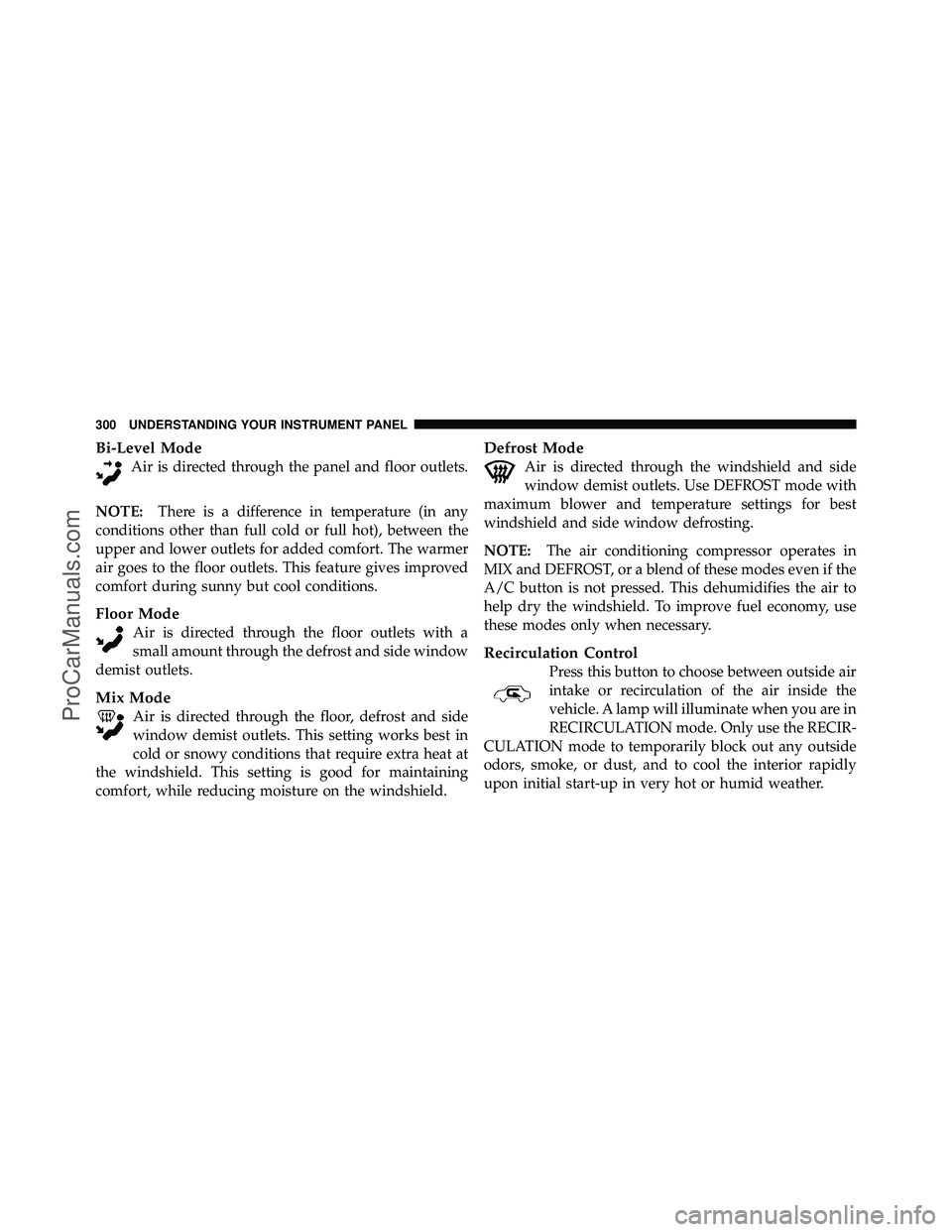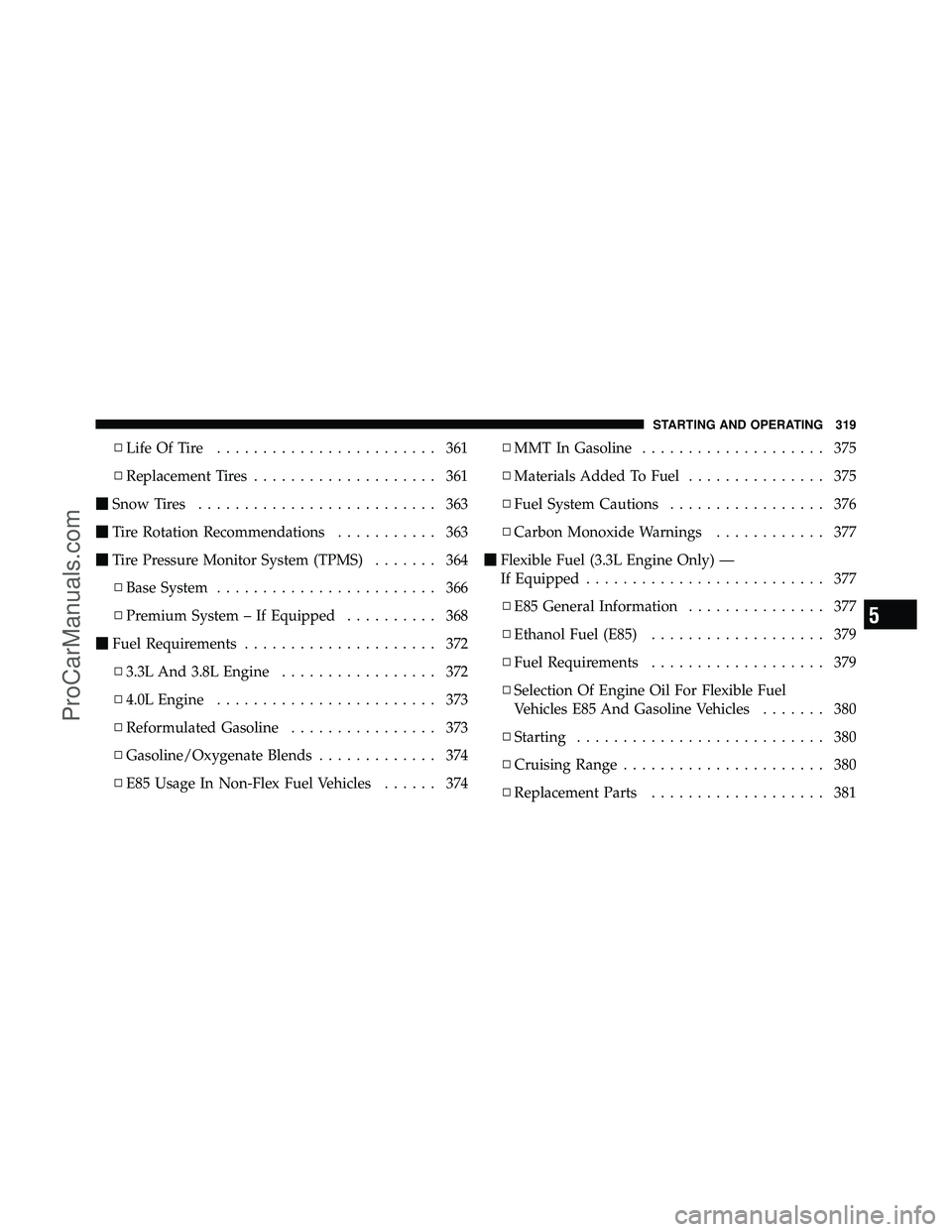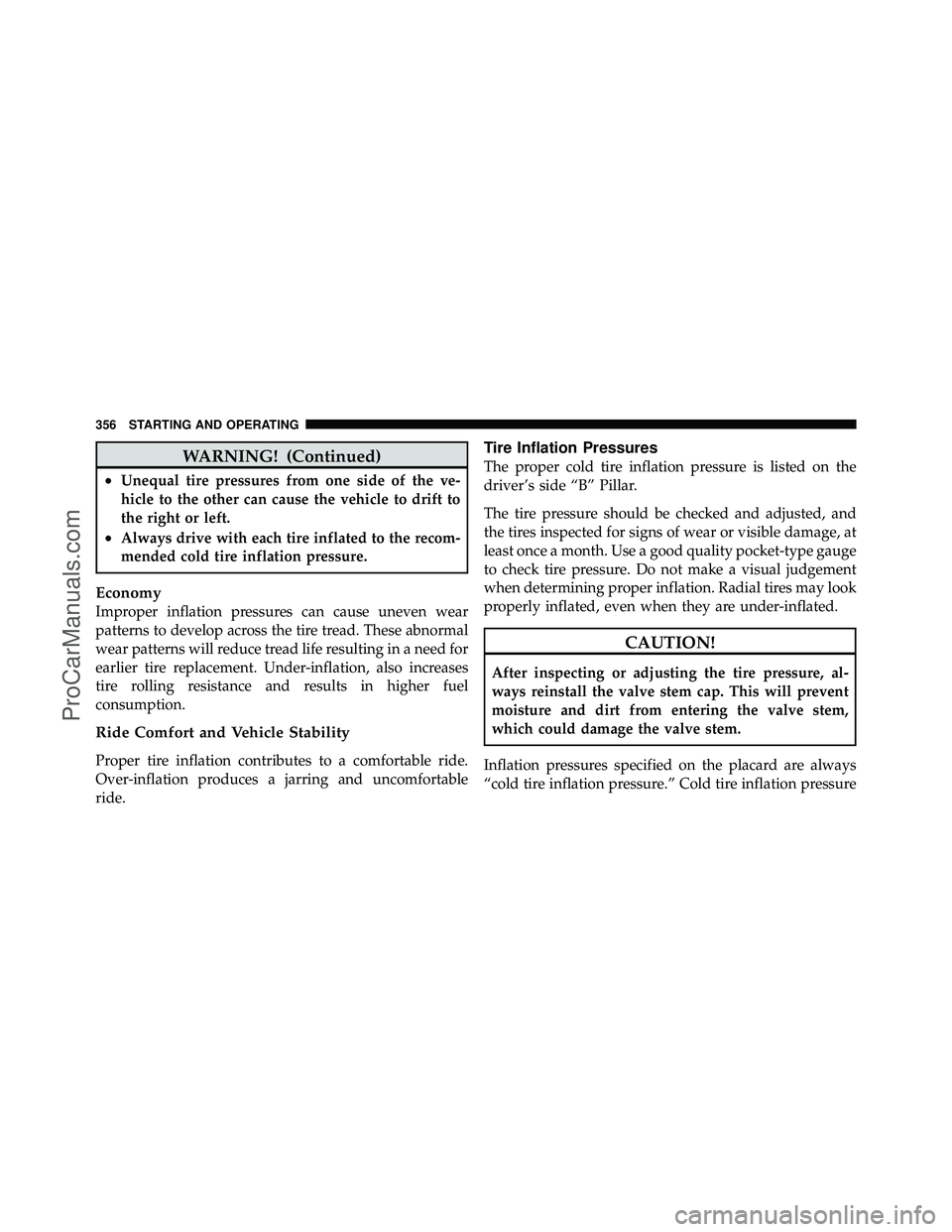Page 250 of 530

Distance To Empty (DTE)
Shows the estimated distance that can be traveled with
the fuel remaining in the tank. This estimated distance is
determined by a weighted average of the instantaneous
and average fuel economy, according to the current fuel
tank level.
NOTE:Significant changes in driving style or vehicle
loading will greatly affect the actual drivable distance of
the vehicle, regardless of the DTE displayed value.
When the DTE value is less than 30 miles (48 km)
estimated driving distance, the DTE display will change
to a text display of �LOW FUEL.�This display will
continue until the vehicle runs out of fuel. Adding a
significant amount of fuel to the vehicle will turn off the
�LOW FUEL� text and a new DTE value will display.
Elapsed Time
Shows the total elapsed time of travel since the last reset
when the ignition switch is in the ACC position. Elapsed
time will increment when the ignition switch is in the ON
or START position.
Display Units of Measure in:
To make your selection, press and release the STEP
button until “ENGLISH” or “METRIC” appears.
To Reset the Display
Reset will only occur while a resettable function is being
displayed. Press and release the RESET button once to
clear the resettable function being displayed. To reset all
resettable functions, press and release the RESET button
a second time, within three seconds of resetting the
currently-displayed function (Reset ALL will display
during this three-second window).
4
UNDERSTANDING YOUR INSTRUMENT PANEL 249
ProCarManuals.com
Page 251 of 530

Compass Display / ECO (Fuel Saver Mode) —
If Equipped
The compass readings indicate the direction
the vehicle is facing. Press and release the
compass button to display one of eight
compass readings, and the outside tempera-
ture.
NOTE: The system will display the last known outside
temperature when starting the vehicle and may need to
be driven several minutes before the updated tempera-
ture is displayed. Engine temperature can also affect the
displayed temperature, therefore temperature readings
are not updated when the vehicle is not moving.
ECO (Fuel Saver Mode) — If Equipped
The ECO message will display below the outside tem-
perature in the EVIC display. This message will appear
whenever you are driving in a fuel efficient manner. This feature allows you to monitor when you are driving
in a fuel efficient manner, and it can be used to modify
driving habits in order to increase fuel economy.
Automatic Compass Calibration
This compass is self-calibrating, which eliminates the
need to manually reset the compass. When the vehicle is
new, the compass may appear erratic and the EVIC will
display CAL until the compass is calibrated. You may
also calibrate the compass by completing one or more
360–degree turns (in an area free from large metal or
metallic objects) until the CAL indicator displayed in the
EVIC turns off. The compass will now function normally.
Manual Compass Calibration
If the compass appears erratic and the CAL indicator
does not appear in the EVIC display, you must put the
compass into the Calibration Mode manually, as follows:
1. Turn ON the ignition switch.
COMPASS
Button
250 UNDERSTANDING YOUR INSTRUMENT PANEL
ProCarManuals.com
Page 301 of 530

Bi-Level Mode
Air is directed through the panel and floor outlets.
NOTE: There is a difference in temperature (in any
conditions other than full cold or full hot), between the
upper and lower outlets for added comfort. The warmer
air goes to the floor outlets. This feature gives improved
comfort during sunny but cool conditions.
Floor Mode
Air is directed through the floor outlets with a
small amount through the defrost and side window
demist outlets.
Mix Mode
Air is directed through the floor, defrost and side
window demist outlets. This setting works best in
cold or snowy conditions that require extra heat at
the windshield. This setting is good for maintaining
comfort, while reducing moisture on the windshield.
Defrost Mode
Air is directed through the windshield and side
window demist outlets. Use DEFROST mode with
maximum blower and temperature settings for best
windshield and side window defrosting.
NOTE: The air conditioning compressor operates in
MIX and DEFROST, or a blend of these modes even if the
A/C button is not pressed. This dehumidifies the air to
help dry the windshield. To improve fuel economy, use
these modes only when necessary.
Recirculation Control
Press this button to choose between outside air
intake or recirculation of the air inside the
vehicle. A lamp will illuminate when you are in
RECIRCULATION mode. Only use the RECIR-
CULATION mode to temporarily block out any outside
odors, smoke, or dust, and to cool the interior rapidly
upon initial start-up in very hot or humid weather.
300 UNDERSTANDING YOUR INSTRUMENT PANEL
ProCarManuals.com
Page 320 of 530

▫Life Of Tire ........................ 361
▫ Replacement Tires .................... 361
� Snow Tires .......................... 363
� Tire Rotation Recommendations ........... 363
� Tire Pressure Monitor System (TPMS) ....... 364
▫ Base System ........................ 366
▫ Premium System – If Equipped .......... 368
� Fuel Requirements ..................... 372
▫ 3.3L And 3.8L Engine ................. 372
▫ 4.0L Engine ........................ 373
▫ Reformulated Gasoline ................ 373
▫ Gasoline/Oxygenate Blends ............. 374
▫ E85 Usage In Non-Flex Fuel Vehicles ...... 374▫
MMT In Gasoline .................... 375
▫ Materials Added To Fuel ............... 375
▫ Fuel System Cautions ................. 376
▫ Carbon Monoxide Warnings ............ 377
� Flexible Fuel (3.3L Engine Only) —
If Equipped .......................... 377
▫ E85 General Information ............... 377
▫ Ethanol Fuel (E85) ................... 379
▫ Fuel Requirements ................... 379
▫ Selection Of Engine Oil For Flexible Fuel
Vehicles E85 And Gasoline Vehicles ....... 380
▫ Starting ........................... 380
▫ Cruising Range ...................... 380
▫ Replacement Parts ................... 381
5
STARTING AND OPERATING 319
ProCarManuals.com
Page 321 of 530
▫Maintenance ........................ 381
� Adding Fuel ......................... 381
▫ Fuel Filler Cap (Gas Cap) .............. 381
▫ Loose Fuel Filler Cap Message ........... 383
� Vehicle Loading ...................... 383
▫ Vehicle Certification Label .............. 383�
Trailer Towing ........................ 387
▫ Common Towing Definitions ............ 387
▫ Towing Tips ........................ 401
� Recreational Towing
(Behind Motorhome, Etc.) ................ 403
320 STARTING AND OPERATING
ProCarManuals.com
Page 323 of 530

Extreme Cold Weather (Below�20°F or –29°C)
Follow the same instructions in the “Normal Starting”
procedure.
To ensure reliable starting at these temperatures, use of
an externally powered electric engine block heater (avail-
able from your authorized dealer) is recommended.
If The Engine Fails To Start
WARNING!
•Never pour fuel or other flammable liquids into
the throttle body air inlet opening in an attempt to
start the vehicle. This could result in a flash fire
causing serious personal injury.
(Continued)
WARNING! (Continued)
•Do not attempt to push or tow your vehicle to get
it started. Vehicles equipped with an automatic
transmission cannot be started this way. Unburned
fuel could enter the catalytic converter and once
the engine has started, ignite and damage the
converter and vehicle.
•If the vehicle has a discharged battery, booster
cables may be used to obtain a start from a booster
battery or the battery in another vehicle. This type
of start can be dangerous if done improperly. Refer
to “Jump Starting” in “What To Do In Emergen-
cies” for further information.
If the engine fails to start after you have followed the
“Normal Starting” procedure, it may be flooded. Push
the accelerator pedal all the way to the floor and hold it
there while cranking the engine. This should clear any
excess fuel in case the engine is flooded.
322 STARTING AND OPERATING
ProCarManuals.com
Page 330 of 530

NEUTRAL
This range is used when vehicle is standing for pro-
longed periods with engine running. Engine may be
started in this range. Set the parking brake if you must
leave the vehicle.
WARNING!
Do not coast in NEUTRAL and never turn off the
ignition to coast down a hill. These are unsafe
practices that limit your response to changing traffic
or road conditions. You might lose control of the
vehicle and have an accident.
DRIVE – Six-Speed Transmission
This range should be used for most city and highway
driving. It provides the smoothest upshifts, downshifts,
and best fuel economy. However, use the Electronic
Range Select (ERS) mode by moving the lever—/+and
select the “5” range when frequent transmission shiftingoccurs while using the DRIVE range, such as when
operating the vehicle under heavy loading conditions,
(i.e., in hilly terrain, traveling into strong head winds or
while towing heavy trailers). Under these conditions,
using the “5” range will improve performance and
extend transmission life by reducing excessive shifting
and heat buildup.
DRIVE – Four-Speed Transmission
This range should be used for most city and highway
driving. It provides the smoothest upshifts, downshifts,
and best fuel economy. However, select the “3” range
when frequent transmission shifting occurs while using
the DRIVE range, such as when operating the vehicle
under heavy loading conditions, (i.e., in hilly terrain,
traveling into strong head winds or while towing heavy
trailers). Under these conditions, using the “3” range will
improve performance and extend transmission life by
reducing excessive shifting and heat buildup.5
STARTING AND OPERATING 329
ProCarManuals.com
Page 357 of 530

WARNING! (Continued)
•Unequal tire pressures from one side of the ve-
hicle to the other can cause the vehicle to drift to
the right or left.
•Always drive with each tire inflated to the recom-
mended cold tire inflation pressure.
Economy
Improper inflation pressures can cause uneven wear
patterns to develop across the tire tread. These abnormal
wear patterns will reduce tread life resulting in a need for
earlier tire replacement. Under-inflation, also increases
tire rolling resistance and results in higher fuel
consumption.
Ride Comfort and Vehicle Stability
Proper tire inflation contributes to a comfortable ride.
Over-inflation produces a jarring and uncomfortable
ride.
Tire Inflation Pressures
The proper cold tire inflation pressure is listed on the
driver’s side “B” Pillar.
The tire pressure should be checked and adjusted, and
the tires inspected for signs of wear or visible damage, at
least once a month. Use a good quality pocket-type gauge
to check tire pressure. Do not make a visual judgement
when determining proper inflation. Radial tires may look
properly inflated, even when they are under-inflated.
CAUTION!
After inspecting or adjusting the tire pressure, al-
ways reinstall the valve stem cap. This will prevent
moisture and dirt from entering the valve stem,
which could damage the valve stem.
Inflation pressures specified on the placard are always
“cold tire inflation pressure.” Cold tire inflation pressure
356 STARTING AND OPERATING
ProCarManuals.com